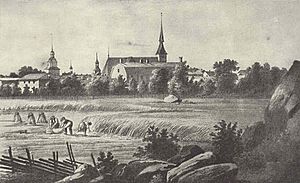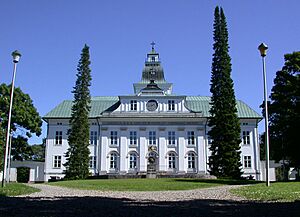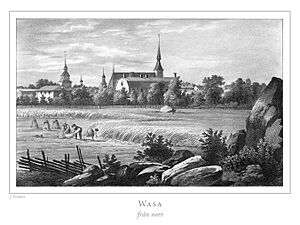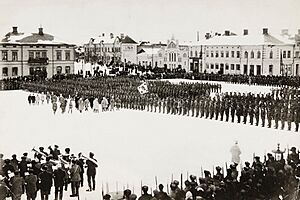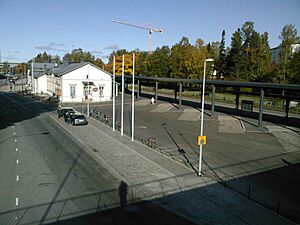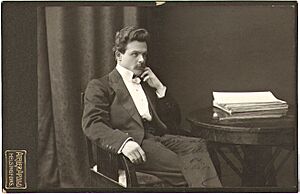Vaasa facts for kids
Quick facts for kids
Vaasa
Vasa (Swedish)
|
|||
|---|---|---|---|
|
City
|
|||
| Vaasan kaupunki Vasa stad City of Vaasa |
|||
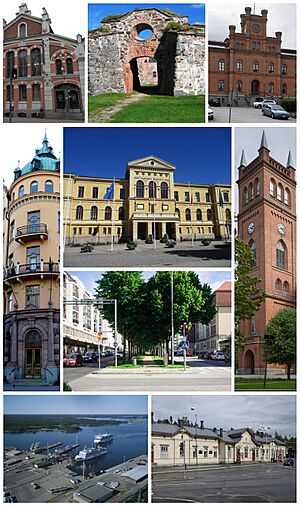
Clockwise from top-left: Vaasa Market Hall, the ruins of Saint Mary Church, the Court of Appeal, the Holy Trinity Church, Vaasa railway station, the Port of Vaasa in Vaskiluoto, and Kurtenia House; and in the middle (from top to bottom) Vaasa City Hall, and the Kauppapuistikko esplanade
|
|||
|
|||
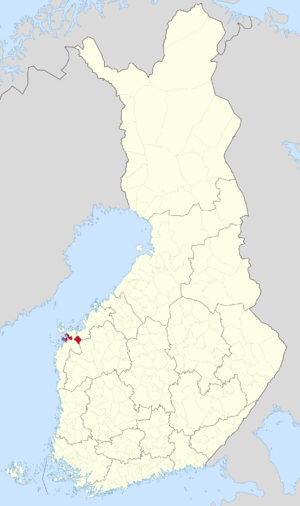
Location of Vaasa in Finland
|
|||
| Country | |||
| Region | |||
| Sub-region | Vaasa sub-region | ||
| Charter | 2 October 1606 | ||
| Named for | House of Vasa Nicholas I of Russia (1855–1917) |
||
| Capital city | 29 January 1918 – 3 May 1918 | ||
| Area
(2018-01-01)
|
|||
| • City | 545.14 km2 (210.48 sq mi) | ||
| • Land | 364.84 km2 (140.87 sq mi) | ||
| • Water | 208.63 km2 (80.55 sq mi) | ||
| • Urban | 66.65 km2 (25.73 sq mi) | ||
| Area rank | 210th largest in Finland | ||
| Population
(2023-12-31)
|
|||
| • City | 68,956 | ||
| • Rank | 14th largest in Finland | ||
| • Density | 189/km2 (490/sq mi) | ||
| • Urban | 65,414 | ||
| • Urban density | 981.5/km2 (2,542/sq mi) | ||
| Population by native language | |||
| • Finnish | 64.7% (official) | ||
| • Swedish | 23.2% (official) | ||
| • Others | 12.1% | ||
| Population by age | |||
| • 0 to 14 | 15% | ||
| • 15 to 64 | 64.4% | ||
| • 65 or older | 20.6% | ||
| Time zone | UTC+02:00 (EET) | ||
| • Summer (DST) | UTC+03:00 (EEST) | ||
| Climate | Dfc | ||
Vaasa (Finnish: [ˈʋɑːsɑ]) is a city in Finland. It is the main city of the Ostrobothnia region. Vaasa is located on the west coast of Finland, right by the Gulf of Bothnia. The city was known as Nikolainkaupunki between 1855 and 1917.
About 69,000 people live in Vaasa. It is one of the largest cities in Finland. Vaasa was founded in 1606 by Charles IX of Sweden. It was named after the Royal House of Vasa.
Vaasa is a very important city for universities and colleges in Finland. It is also a bilingual city. This means both Finnish and Swedish are official languages. Most people speak Finnish, but many also speak Swedish. This makes Vaasa a key cultural center for Swedish-speaking people in Finland.
You can find Tropiclandia Water Park in Vaasa. It is on Vaskiluoto Island, next to a spa hotel. There used to be an amusement park called Wasalandia nearby, but it closed in 2015.
Contents
History of Vaasa
City Name Changes
Vaasa's name has changed many times over the years. This happened because of different spellings and political reasons.
- First, it was called Mustasaari (Finnish) or Mussor (Swedish) in 1606. This was the name of the village where it was founded.
- A few years later, its name changed to Vasa. This was to honor the Swedish royal family.
- From 1855 to 1917, it was called Nikolajstad (Swedish) and Nikolainkaupunki (Finnish). This name honored Nicholas I of Russia, who was the Russian Czar.
- After 1917, the name went back to Vasa (Swedish) and Vaasa (Finnish). The Finnish spelling became the main one around 1930. This was when more Finnish speakers lived in the city.
How Vaasa Was Founded
The history of Vaasa started in the 14th century. Sailors from Sweden came to the area of Old Vaasa. A church was built in the mid-1300s. A fortress called Crysseborgh was built in the 1370s. This fortress became an important administrative center.
King Charles IX of Sweden officially founded the town on October 2, 1606. It was built near the old harbor. In 1611, the town got its official charter. It was then renamed Vasa, after the Royal House of Vasa.
Vaasa grew a lot in the 1600s. This was thanks to its sea connections, shipbuilding, and trade. Many people earned their living from the tar trade.
In 1683, a school moved to Vaasa. The first library in Finland opened in Vaasa in 1794. By 1793, Vaasa had 2,178 people. Just before a big fire in 1852, the population grew to 3,200.
The Finnish War
Vaasa suffered a lot during the Finnish War (1808–1809). This war was fought between Sweden and Russia. In June 1808, Russian forces took over Vaasa.
On June 25, 1808, Swedish troops tried to free Vaasa. They fought the Russian soldiers in the streets. But the Swedish forces had to retreat. The Russian general thought the people of Vaasa had helped the Swedes. So, his men looted and destroyed the city for several days. Many people were hurt, and 17 civilians were killed. This was unusual for the Russian forces during this war.
On June 30, the Russians left Vaasa. But they came back on September 13. The next day, Russia won a big battle nearby. By the winter of 1808, Russia had taken over all of Finland. In 1809, Sweden lost Finland to Russia. Vaasa became part of the new Grand Duchy of Finland. This was a part of the Russian Empire.
The Great Town Fire
In 1852, a huge fire destroyed most of Vaasa. The town was mostly made of wood and built very close together. The fire started in a barn on August 3. By noon, the whole town was burning. Most of the town burned to the ground.
Only 24 private buildings out of 379 survived. One of them was the Falander–Wasastjerna house. It was built in 1780–1781 and is now the Old Vaasa Museum. The Court of Appeal building also survived. Today, this building is the Church of Korsholm. Some Russian guard-houses and a hospital also survived.
You can still see the ruins of the old church, its bell tower, the town hall, and the school. Many old records about Vaasa were lost in the fire. People say the fire started when a visitor accidentally dropped his pipe in dry hay.
Building a New Town
After the fire, a new town was built in 1862. It was about 7 kilometers (4.3 miles) northwest of the old town. The new town was named Nikolaistad, after Czar Nicholas I. Its location by the sea was great for shipping.
The new town was designed by Carl Axel Setterberg. He used a style called Empire style. He made sure to learn from the fire. The main streets were five wide avenues. These avenues divided the town into sections. Each section was also divided by smaller alleys. This design helped prevent fires from spreading easily.
The town was renamed Vaasa in 1917. This happened after Czar Nicholas II was overthrown.
Vaasa as Finland's Capital
During the Finnish Civil War in 1918, Vaasa became the capital of Finland. This was from January 29 to May 3, 1918. The government (called the Senate) moved to Vaasa. This happened because Helsinki was occupied. The White Guards, who supported the Senate, were strong in Vaasa. Also, it was easy to get help from Western countries from Vaasa.
The Senate started working in Vaasa on February 1, 1918. They met in the Town Hall. To thank the city, the Senate gave Vaasa a special honor. Vaasa could add the Cross of Freedom to its coat of arms. This is Finland's oldest honor. Because of its role in the war, Vaasa became known as "The White City." A Statue of Freedom was put up in the town square. It shows a winning White soldier.
Vaasa After the Wars
In the 1930s, more people in Vaasa started speaking Finnish. So, the main name changed from "Vasa" to "Vaasa."
After World War II, Vaasa became more industrial. A big electronics company, Strömberg (now part of ABB), led this growth.
In 2013, the nearby area of Vähäkyrö joined Vaasa. It is now a part of the city, but it is surrounded by other towns.
Vaasa's Climate
Vaasa is close to the Arctic Circle. It has a continental subarctic climate. This means it has cold, dry winters and warm summers. The winds and the nearby Gulf of Bothnia make the climate milder than you might expect for its location.
The average yearly temperature is about 4.7 °C (40.5 °F). The area usually gets little snow. But sometimes, cold air meets warm, wet air, causing heavy snowfall. Summers tend to be drier. The highest temperature ever recorded in Vaasa was 32.2 °C (89.6 °F) on July 18, 2018.
Vaasa's Population
How Many People Live Here?
The city of Vaasa has about 68,956 people. This makes it the 14th most populated city in Finland. The larger Vaasa region has about 110,163 people. About 12.4% of the people in Vaasa have a foreign background. This is higher than the average for Finland.
| Year | Population |
|---|---|
| 1990 |
58,394
|
| 1995 |
60,399
|
| 2000 |
61,470
|
| 2005 |
61,889
|
| 2010 |
64,345
|
| 2015 |
67,619
|
| 2020 |
67,551
|
Languages Spoken
Population by mother tongue (2023) Finnish (64.7%) Swedish (23.2%) Arabic (1.1%) Russian (0.9%) English (0.9%) Ukrainian (0.7%) Persian (0.6%) Other (7.8%)
Vaasa is an officially bilingual city. Both Finnish and Swedish are official languages. Most people, about 64.7% of the population, speak Finnish as their first language. About 23.2% of the people speak Swedish.
About 12.1% of the people in Vaasa speak a language other than Finnish or Swedish. Many people in Vaasa can speak two or even three languages. This is because English and Swedish (or Finnish for Swedish speakers) are required subjects in school.
More than 50 different languages are spoken in Vaasa. The most common foreign languages are Arabic, Russian, English, and Ukrainian.
Vaasa's Economy
Vaasa is mainly an industrial city. About a quarter of all jobs are in industry.
The city has several universities. These include the University of Vaasa, Åbo Akademi, and Hanken. There are also two universities of applied sciences. Many people who work in Vaasa live in nearby towns.
The Vaskiluoto power stations are on Vaskiluoto Island. They provide electricity to the country. They also provide heat to the city.
The Port of Vaasa is also in Vaskiluoto. It is used for both cargo and passengers. You can travel from Vaasa to Umeå, Sweden, and other places.
Getting Around Vaasa
Major roads connect Vaasa to other big cities in Finland. These include Helsinki, Tampere, and Oulu. The distance from Helsinki to Vaasa is about 419 kilometers (260 miles).
Vaasa Airport is about nine kilometers (5.6 miles) southeast of the city center. You can fly from Vaasa Airport to Helsinki and Stockholm.
Culture in Vaasa
Vaasa has many museums and art spaces:
- Ostrobothnian Museum
- Terranova Museum
- Meteoriihi
- Kuntsi Museum of Modern Art
- Vaasa Car & Motor Museum
- Platform, an art gallery for contemporary art, media art, and sound art
Other Places to See
- The Statue of Liberty (Suomen Vapaudenpatsas)
Sports in Vaasa
Vaasa has many sports teams:
- Vaasan Sport: A men's ice hockey team that plays in the top league, Liiga.
- Vaasan Mailattaret: A women's Finnish baseball team.
- Vaasan Sport Naiset: A women's ice hockey team.
- Vaasan Palloseura: A men's football club that plays in the top league, Veikkausliiga.
- Vasa IFK: A men's football club.
- FC Kiisto: A men's football club.
- Vaasa Rugby Club: Includes the Vaasa Wolves (men's rugby union) and Vaasa Foxes (women's rugby sevens).
Education in Vaasa
Vaasa is home to three universities:
- The University of Vaasa: This is the largest one. It is located in the Palosaari area.
- Åbo Akademi: This university has its main campus in Turku, but it has a branch in Vaasa.
- Hanken School of Economics: This university has its main campus in Helsinki, but it also has a branch in Vaasa.
Vaasa also has two universities of applied sciences:
- Vaasa University of Applied Sciences
- Novia University of Applied Sciences
About 13,000 students attend universities in Vaasa. Another 4,000 students attend vocational schools.
Famous People from Vaasa
- Fanny Churberg (1845–1892) – Painter
- Seppo Evwaraye – Professional American football player
- Kai Hahto - Metal Drummer
- Jarl Hemmer – Author
- Mikaela Ingberg – Javelin thrower
- Fritz Jakobsson – Painter
- Vesa 'Vesku' Jokinen – Musician
- Mikael Jungner – MD of Yleisradio
- Toivo Kuula – Composer
- Jani Liimatainen – Guitar player
- Matias Mäkynen – Politician
- Nandor Mikola – Painter
- Camilla Nylund – Opera singer
- Oskar Osala – Ice hockey player
- Pekka Puska – Doctor and public health expert
- Viljo Revell – Architect
- Camilla Richardsson – Runner
- Leif Segerstam – Musician, composer, conductor
- Monica Aspelund – Singer
- Carl Axel Setterberg – Architect who designed the new Vaasa
- Pekka Strang – Actor
- Jani Toivola – Politician, actor, TV host
- Onni Tommila – Actor
- Allu Tuppurainen – Actor, creator of Rölli
- Jenny Wilhelms – Musician
- Mathilda Wrede – "Friend of the inmates"
- Yrjö Sakari Yrjö-Koskinen – Politician, professor
- Håkan Nyblom – Finnish wrestler
- Miika Koivisto – Ice hockey player
- Jukka Seppo - Ice hockey player
- Lauri Tähkä - Singer/songwriter
- Vappu Taipale - Psychiatrist and politician
- Juha Tapio - Singer, lyricist, composer and guitarist
Sister Cities
Vaasa has special agreements with ten cities around the world. These are called twin towns or sister cities. They help promote cultural exchange and friendship.
| City | Province | Country | Year |
|---|---|---|---|
| Malmö | 1940 | ||
| Umeå | 1940 | ||
| Harstad | 1949 | ||
| Helsingør | Capital Region of Denmark | 1949 | |
| Pärnu | 1956 | ||
| Schwerin | 1965 | ||
| Kiel | 1967 | ||
| Šumperk | 1984 | ||
| Morogoro | 1988 | ||
| Bellingham | 2009 |
Images for kids
See also
 In Spanish: Vaasa para niños
In Spanish: Vaasa para niños




